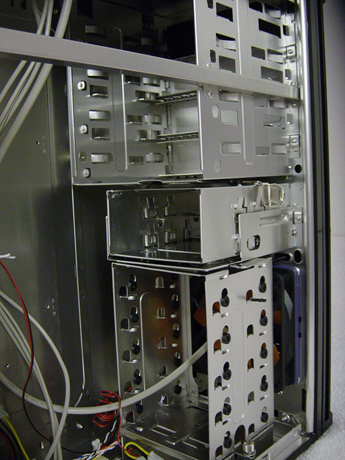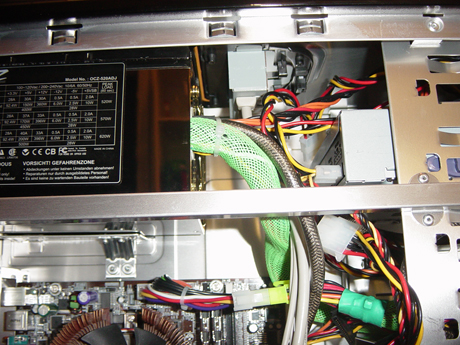Thermaltake Tsunami: A Complete Visual Overhaul
by Purav Sanghani on September 10, 2004 12:00 PM EST- Posted in
- Cases/Cooling/PSUs
Internal Design
After removing the right side panel, we took a closer look at the Tsunami's aluminum insides. Though the size of the case compares to that of the Cooler Master Centurion and the Enermax Sea Hawk, we were amazed at how much Thermaltake packed into the Tsunami.At the front of the case reside the drive bays. There are four 5-1/4" drive bays at the top. Thermaltake has carried on their drive rail idea to the Tsunami and has included enough to install the four 5-1/4" drives without any hassle. A tool-less design isn't fully implemented, but the most important areas do have devices to make installation much easier.
Below those bays are two 3-1/2" floppy bays and this is where things get interesting. This bay can be removed by pulling back on the spring clip and pulling the carriage back. We did see a flaw in this design in that while components like the motherboard are installed, the carriage cannot be easily removed from its place. These bays do not use drive rails and require screws to secure floppy drives.
A total of 5 HDD's can be mounted in the second removable drive carriage at the bottom of the case. The bays have rubber mounts to absorb any shock that could damage installed hard drives. Thermaltake has included thumbscrews to mount HDD's in place. This carriage is also easily removable, unlike the first one, by removing the thumbscrew which anchors the bay, pressing down on the release and pulling the carriage outwards to the left side of the case.
Moving on to the expansion slots, we see a new securing device for expansion cards. Instead of sliding clips, which Thermaltake has used in the past, we noticed that they implemented a new horizontally pivoting clip, which holds cards in place. They are just as effective, if not more, as the sliding clips.
Looking up to where the power supply is mounted, we noticed the lack of space needed to install an oversized unit, or any unit at all, successfully. The bundle of wiring from the auxiliary ports at the top of the case interfered and needed to be removed in order to slide the power supply in place. The cross bar that provides support to the chassis structure, since it is aluminum, was also a block in the road, but we figured there was nothing that the manufacturer could do to get rid of this. We installed our test bed motherboard in the Tsunami first, so our Zalman heatsink fan became a huge problem also. Instead of removing the heatsink, we decided it would be easier to remove the auxiliary pod. Our OCZ PowerStream just barely slid into place.














31 Comments
View All Comments
Spectatohead - Friday, March 25, 2005 - link
I have the original Audigy. I think the Audigy drive is the same. The front cover closes fine. The knobs don't seem to even touch the back of it. Of course the door has to be open to plug headphones, or anything else, into it. I have looked to see if the Audigy has a connector for an external headphone jack so I could use the top connector, but I can't find one. This is a great case. I got the plain silver version. The floppy bay is a bit funky but other than that everything else installs easily.bigdane - Friday, December 31, 2004 - link
#29, Did you have any luck any finding an answer to your question? I am considering the same case with the same issue.yomper - Wednesday, December 22, 2004 - link
Does anybody know if there is any problem closing the front cover of the Tsunami with a SB Audigy 2 front panel installed? I haven't seen this case in the flesh yet, and am wondering if the curved bezel provides enough clearance for the volume knobs on the Audigy line's 5.25" connector panel. (I'd rather not clutter up my desk further with the external connector box of the Pro model of the Audigy 2.)alzheimer - Wednesday, November 24, 2004 - link
I had no problem with instaling PSU after mobo. I have one question. Is ist possible to regulate rpm of 2 12cm fans with multifunction panel?drunknasasin - Sunday, October 3, 2004 - link
This case is nice, I've worked with a couple of them. The only problem that will arrise is mounting a larger Power Supply. It soon becomes a puzzle, and frustrating. Once the Power supply is mounted, the rest is easy.flyboy84 - Wednesday, September 15, 2004 - link
Just got the case, it's beautiful!Can't wait to build the system over the weekend :-D
Ringthane - Tuesday, September 14, 2004 - link
I have the case... did not install PSU until after mobo was in place. This required the top mounted USB/firewire/audio jack ports to be removed (4 screws). Probably would have needed to remove the usb ports even if I hadn't installed the mobo first (600w PSU). It was a biatch getting the PSU in, plus I broke one of the small plastic hinges on the usb cover (Thermaltake replaced FOC). It's all in now and looks great, but it is not a quiet ride.Front door is fine of you're not rough with it, but heh, it's a computer case not a football.
treadhed - Saturday, September 11, 2004 - link
I'm done with thermaltake. The designers of this company have got to be smoking crack, because the Xaser was the most regressive design I have ever seen as far as usability and installation is concerned. Now it is eating power supplies. Number two just went out, and I'm going to go get another case, one I can put my hands on and look at before I buy it. I will never buy a case over the internet again. I do not expect the Tsunami to be any more friendly or innovative in design. Expect the worst.deathwalker - Saturday, September 11, 2004 - link
I have a real problem with cases like this...with front doors that open. I see these doors as just one more problem area....something else you can break too easily.GhandiInstinct - Friday, September 10, 2004 - link
Purav, could you answer my question please?